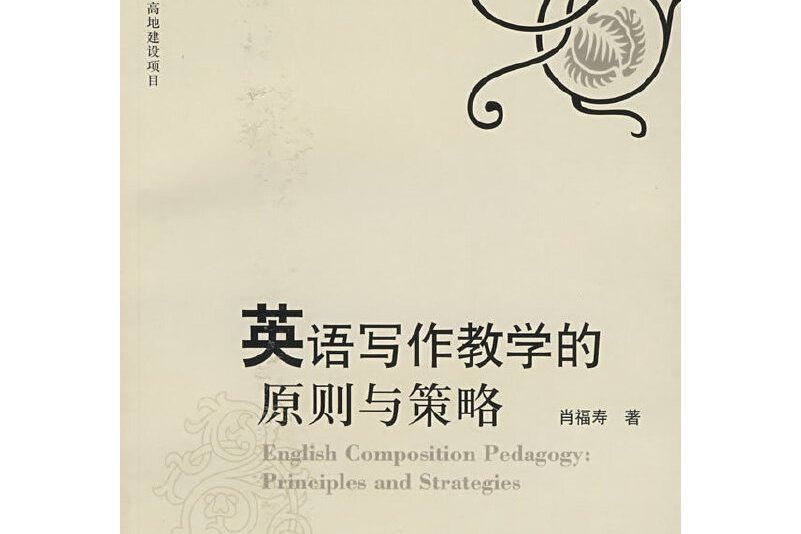《英語寫作教學的原則與策略》是2007年6月上海大學出版社出版的圖書,作者是肖福壽。
基本介紹
- 中文名:英語寫作教學的原則與策略
- 作者:肖福壽
- 出版社:上海大學出版社
- 出版時間:2007年6月
- ISBN:9787811180947

《英語寫作教學的原則與策略》是2007年6月上海大學出版社出版的圖書,作者是肖福壽。
《英語寫作教學的原則與策略》是2007年6月上海大學出版社出版的圖書,作者是肖福壽。1內容簡介本書力求反映英語寫作教學與研究方面的*理論與實踐成果,通過大量真實而鮮活的例子,全面系統地探索了寫作的本質、寫作的原理、寫作的...
英語寫作教學策略 《英語寫作教學策略》是廣東科技出版社出版的圖書,作者是李廣超
《英語新課程和教學模式與教學策略》是2004年10月1日上海教育出版社出版的圖書,作者是黃文源。本書將語言技能、語言知識、情感態度、學習策略和文化意識融為一體,為學生未來發展和終身教育奠定良好基礎。內容簡介 將語言技能、語言知識、...
《高考英語寫作:策略篇》通過介紹高考英語作文的考試大綱和評分原則,讓學生了解測試的目的和要求,使學生寫作時做到心中有數,有的放矢。高考常見文體寫作技巧、常見錯誤與修改、高分作文三大策略提供高考寫作秘訣高招,幫助考生在考場揮灑...
《英語教學中的學習策略培訓:閱讀與寫作》是外語教學與研究出版社出版的圖書,作者是顧永琦。該書精心設計了策略培訓模式和素材,教師通過這些行之有效的方式,可切實幫助學生掌握各種學習策略,並鼓勵學生將其廣泛運用於學習之中,逐漸形成...
對所得的有聲思維實驗報告及訪談材料進行了分析,旨在探討元認知策略與英語寫作能力的相關性。嘗試探討高中生在二語寫作的認知思維過程,關注學生英文寫作中的構思、成文、修改等策略,探索影響二語寫作能力發展的因素。
《雅思考試寫作策略》遵循外語教學的客觀規律,寓講、練於一體,不僅滿足我國雅思考生寫作考試的實際需求,而且適用於我國大學生英語四、六級寫作考試、研究生入學英語寫作考試及托福、GRE等寫作考試的各類要求;不僅適用於大學英語教師課堂教學...
對於大多數英語教師和學習者來說,寫作都無異於超艱巨的任務。本書聚焦英語寫作中的教與學,詳解寫作作業的定義和描述、寫作作業的題目和選擇、助力學習者的手段、適合學習者的流程和策略、寫作反饋,以及寫作評估方法等幾大方面,試圖...
第三節 寫作教學策略 第十章 語法教學策略 第一節 語法教學的含義 第二節 語法教學的原則 第三節 語法教學策略 第十一章 英語課堂教學的準備和策略的培養 第一節 課前準備 第二節 認知策略和元認知策略的培養 參考資料 ...
《教師教育精品·有效英語教學:如何教寫作》為教師提供了課堂活動組織的詳細步驟和案例,具有很強的操作性,可以作為教師英語寫作教學的好幫手。作者傅丹靈和王志軍的把寫作技能的培養和考試技巧的培養有機地結合起來。在培養學生寫作能力的...
二、教學策略研究的現狀 三、教學策略產生的途徑 四、教學策略研究的意義 第二章 英語教學組織策略 第一節 課前準備策略 一、教學目標分析策略 二、教學主體分析策略 三、教學材料選擇策略 第二節 課堂組織的原則與策略 一、課堂組織...
《高考英語寫作高分策略與範文》是2021年清華大學出版社出版的圖書。內容簡介 本書依據《普通高中英語課程標準》和高考英語書面表達評分標準,詳細講解高考英語三種寫作題型: 套用文、讀後續寫和概要寫作的撰寫。針對每一種題型,本書從立意...
本書對高考英語作文中常用的辭彙、詞組以及句式分類作了簡要講解,並配有與高考英語作文相關的例句。本書是提高學生高考英語作文成績的好助手,也是教師實用的教學參考資料。目錄 第一章 高考英語作文解題技巧 第一節 高考對英語作文的要求...
第二節聽說教學規劃 第三節聽說教學設計 第四節聽說教學實施策略 第七章國中英語閱讀教學策略 第一節國中英語教學規劃 第二節閱讀教學設計 第三節閱讀教學的實施 第八章國中英語寫作教學策略 第一節寫作教學規劃 第二節寫作教學設計 第...
第十六章 英語寫作教學 第一節 英語寫作教學概述 第二節 英語寫作教學的理論模式 第三節 英語寫作教學原則和策略 第四編 英語教師素質與專業發展 第十七章 英語教師的素質研究 第一節 教師素質概述 第二節 英語教師的素質 第三節 ...
《思辨與明理:高中英語議論文寫作教學指導》是2021年上海教育出版社出版的圖書。內容簡介 根據國家課標對學生核心素養的要求,思辨能力的培養對於高中生的英語寫作、聽說技能提升有至關重要的作用。高中教師自身的思辨能力也存在欠缺。因此本...
中學英語教師儘管在寫作教學做了很多努力,但它仍然是薄弱的教學板塊。教師很需要了解:如何構建一個完整的國中英語寫作系統?如何設計合適的寫作話題?基於不同寫作課型下如何使用相應的方法和策略?如何科學地評價學生習作?如何幫助學生重構...
理論與實踐相結合是英語教學論文寫作應遵循的一項基本原則。第六、英文畢業論文摘要各部分的寫作 根據《EI》對英文摘要的寫作要求,英文摘要的寫作並沒有一成不變的格式,但一般來說,英文摘要是對原始文獻不加詮釋或評論的準確而簡短的...
★ 語言能力和文化素質的同步提升:注重培養學習者的英語思維習慣,開拓跨文化交際視野,實現語言綜合套用能力和人文素養的全面提高。★ 分類指導和因材施教的教學原則:綜合、視聽說、閱讀、寫作、快速閱讀等主幹教程和經貿、文化類選修課...
英語寫作教學 《英語寫作教學》是一本圖書,作者是蘭良平,韓剛
英語寫作教學 《英語寫作教學》是人民教育出版的圖書,作者是布魯克斯
重技巧是本書特色。圖書目錄 第一部分大學英語作文結構與模式 1. 作文考試的模式 第二部分大學英語作文技巧 2. 寫好作文的訣竅 3. 高分作文策略 4. 作文訓練的技巧 5. 命題與評分 第三部分附錄 6. 常考句型及範文 ...
52、中學英語寫作要在寫的過程中下功夫 53、分析文體,培養學生的寫作策略 54、抓住英語作文的批改要點 55、翻譯教學可讓學生養成根據上下文關係進行推測思維的習慣 56、歸納教學法,可以提高語法課的效率 57、綜合技能課的目標與任務設計...
英文寫作常見問題與對策 《英文寫作常見問題與對策》是上海科學技術出版社出版的圖書,作者是於萬鎖、朱婷。
第二章 國小英語對話課型 第三章 國小英語語音課型 第四章 國小英語辭彙課型 第五章 國小英語語法課型 第六章 國小英語閱讀課型 第七章 國小英語寫作課型 第八章 國小英語繪本課型 第九章 國小英語故事課...
《全國高等學校外語教師叢書·教學研究系列:英語寫作教學與研究》系統介紹了如何進行英語寫作教學與研究,全書分為教學篇和研究篇兩大部分。教學篇有四章:第一章回顧和評介寫作教學法,探討寫作教學的基本步驟和教學理念,以及有效地組織...
